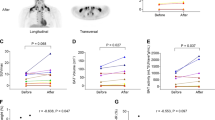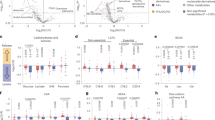Abstract
Therapeutic increase in brown adipose tissue (BAT) thermogenesis is of great interest, as BAT activation counteracts obesity and insulin resistance. Hyaluronan (HA) is a glycosaminoglycan, found in the extracellular matrix, that is synthesized by HA synthases (HAS1, HAS2, and HAS3) from sugar precursors and accumulates in diabetic conditions. Its synthesis can be inhibited by the small molecule 4-methylumbelliferone (4-MU). Here we show that inhibition of HA synthesis by 4-MU or genetic deletion of Has2 and Has3 improves the thermogenic capacity of BAT, reduces body-weight gain, and improves glucose homeostasis independently of adrenergic stimulation in mice on a diabetogenic diet. In this context, we validated a novel magnetic resonce T2 mapping approach for in vivo visualization of BAT activation. Inhibition of HA synthesis increases glycolysis, BAT respiration, and uncoupling protein 1 (UCP1) expression. In addition, we show that 4-MU increases BAT capacity without inducing chronic stimulation and propose that 4-MU, a clinically approved, prescription-free drug, could be repurposed to treat obesity and diabetes.
This is a preview of subscription content, access via your institution
Access options
Access Nature and 54 other Nature Portfolio journals
Get Nature+, our best-value online-access subscription
$29.99 / 30 days
cancel any time
Subscribe to this journal
Receive 12 digital issues and online access to articles
$119.00 per year
only $9.92 per issue
Buy this article
- Purchase on Springer Link
- Instant access to full article PDF
Prices may be subject to local taxes which are calculated during checkout







Similar content being viewed by others
Data availability
Data that support the findings of this study are available from the corresponding author upon reasonable request.
References
Cypess, A. M. et al. Identification and importance of brown adipose tissue in adult humans. N. Engl. J. Med. 360, 1509–1517 (2009).
Virtanen, K. A. et al. Functional brown adipose tissue in healthy adults. N. Engl. J. Med. 360, 1518–1525 (2009).
Hondares, E. et al. Thermogenic activation induces FGF21 expression and release in brown adipose tissue. J. Biol. Chem. 286, 12983–12990 (2011).
Bartelt, A. et al. Brown adipose tissue activity controls triglyceride clearance. Nat. Med. 17, 200–205 (2011).
Orava, J. et al. Different metabolic responses of human brown adipose tissue to activation by cold and insulin. Cell Metab. 14, 272–279 (2011).
Guerra, C., Koza, R. A., Yamashita, H., Walsh, K. & Kozak, L. P. Emergence of brown adipocytes in white fat in mice is under genetic control. Effects on body weight and adiposity. J. Clin. Invest. 102, 412–420 (1998).
Lee, P. et al. Temperature-acclimated brown adipose tissue modulates insulin sensitivity in humans. Diabetes 63, 3686–3698 (2014).
Global BMI Mortality Collaboration. Body-mass index and all-cause mortality: individual-participant-data meta-analysis of 239 prospective studies in four continents. Lancet 388, 776–786 (2016).
Berbee, J. F. et al. Brown fat activation reduces hypercholesterolaemia and protects from atherosclerosis development. Nat. Commun. 6, 6356 (2015).
Shimizu, I. et al. Vascular rarefaction mediates whitening of brown fat in obesity. J. Clin. Invest. 124, 2099–2112 (2014).
Stanford, K. I. et al. Brown adipose tissue regulates glucose homeostasis and insulin sensitivity. J. Clin. Invest. 123, 215–223 (2013).
Cypess, A. M. et al. Activation of human brown adipose tissue by a β3–adrenergic receptor agonist. Cell Metab. 21, 33–38 (2015).
Bortolini, M., Wright, M. B., Bopst, M. & Balas, B. Examining the safety of PPAR agonists—current trends and future prospects. Expert Opin. Drug Saf. 12, 65–79 (2013).
Camporez, J. P. et al. Cellular mechanisms by which FGF21 improves insulin sensitivity in male mice. Endocrinology 154, 3099–3109 (2013).
Van Marken Lichtenbelt, W. D. et al. Cold-activated brown adipose tissue in healthy men. N. Engl. J. Med. 360, 1500–1508 (2009).
Vijgen, G. H. et al. Brown adipose tissue in morbidly obese subjects. PLoS One 6, e17247 (2011).
Vigetti, D. et al. Role of UDP-N-acetylglucosamine (GlcNAc) and O-GlcNAcylation of hyaluronan synthase 2 in the control of chondroitin sulfate and hyaluronan synthesis. J. Biol. Chem. 287, 35544–35555 (2012).
Kang, L. et al. Hyaluronan accumulates with high-fat feeding and contributes to insulin resistance. Diabetes 62, 1888–1896 (2013).
Lee, P. et al. Brown adipose tissue exhibits a glucose-responsive thermogenic biorhythm in humans. Cell Metab. 23, 602–609 (2016).
Kakizaki, I. et al. A novel mechanism for the inhibition of hyaluronan biosynthesis by 4-methylumbelliferone. J. Biol. Chem. 279, 33281–33289 (2004).
Peirce, V., Carobbio, S. & Vidal-Puig, A. The different shades of fat. Nature 510, 76–83 (2014).
Chondronikola, M. et al. Brown adipose tissue improves whole-body glucose homeostasis and insulin sensitivity in humans. Diabetes 63, 4089–4099 (2014).
De Meis, L., Ketzer, L. A., Camacho-Pereira, J. & Galina, A. Brown adipose tissue mitochondria: modulation by GDP and fatty acids depends on the respiratory substrates. Biosci. Rep. 32, 53–59 (2012).
Vigetti, D., Viola, M., Karousou, E., De Luca, G. & Passi, A. Metabolic control of hyaluronan synthases. Matrix Biol. 35, 8–13 (2014).
Carriere, A. et al. Browning of white adipose cells by intermediate metabolites: an adaptive mechanism to alleviate redox pressure. Diabetes 63, 3253–3265 (2014).
Hui, S. et al. Glucose feeds the TCA cycle via circulating lactate. Nature 551, 115–118 (2017).
Blondin, D. P. et al. Inhibition of intracellular triglyceride lipolysis suppresses cold-induced brown adipose tissue metabolism and increases shivering in humans. Cell Metab. 25, 438–447 (2017).
Irshad, Z., Dimitri, F., Christian, M. & Zammit, V. A. Diacylglycerol acyltransferase 2 links glucose utilization to fatty acid oxidation in the brown adipocytes. J. Lipid Res. 58, 15–30 (2017).
De Bock, K. et al. Role of PFKFB3-driven glycolysis in vessel sprouting. Cell 154, 651–663 (2013).
Mahdaviani, K., Chess, D., Wu, Y., Shirihai, O. & Aprahamian, T. R. Autocrine effect of vascular endothelial growth factor-A is essential for mitochondrial function in brown adipocytes. Metabolism 65, 26–35 (2016).
Sim, M. O., Ham, J. R., Lee, H. I., Seo, K. I. & Lee, M. K. Long-term supplementation of umbelliferone and 4-methylumbelliferone alleviates high-fat diet induced hypertriglyceridemia and hyperglycemia in mice. Chem. Biol. Interact. 216, 9–16 (2014).
Ji, E. et al. Inhibition of adipogenesis in 3T3-L1 cells and suppression of abdominal fat accumulation in high-fat diet–feeding C57BL/6J mice after downregulation of hyaluronic acid. Int. J. Obes. 38, 1035–1043 (2014).
Chen, Y. I. et al. Anatomical and functional assessment of brown adipose tissue by magnetic resonance imaging. Obesity 20, 1519–1526 (2012).
Khanna, A. & Branca, R. T. Detecting brown adipose tissue activity with BOLD MRI in mice. Magn. Reson. Med. 68, 1285–1290 (2012).
Quaranta, S., Rossetti, S. & Camarri, E. Double-blind clinical study on hymecromone and placebo in motor disorders of the bile ducts after cholecystectomy. Clin. Ter. 108, 513–517 (1984).
Abate, A. et al. Hymecromone in the treatment of motor disorders of the bile ducts: a multicenter, double-blind, placebo-controlled clinical study. Drugs Exp. Clin. Res. 27, 223–231 (2001).
Trabucchi, E. et al. Controlled study of the effects of tiropramide on biliary dyskinesia. Pharmatherapeutica 4, 541–550 (1986).
Kalinovich, A. V., de Jong, J. M., Cannon, B. & Nedergaard, J. UCP1 in adipose tissues: two steps to full browning. Biochimie 134, 127–137 (2017).
Kobayashi, N. et al. Hyaluronan deficiency in tumor stroma impairs macrophage trafficking and tumor neovascularization. Cancer Res. 70, 7073–7083 (2010).
Matsumoto, K. et al. Conditional inactivation of Has2 reveals a crucial role for hyaluronan in skeletal growth, patterning, chondrocyte maturation and joint formation in the developing limb. Development 136, 2825–2835 (2009).
Seibler, J. et al. Rapid generation of inducible mouse mutants. Nucleic Acids Res. 31, e12 (2003).
Kiene, L. S. et al. Deletion of hyaluronan synthase 3 inhibits neointimal hyperplasia in mice. Arterioscler. Thromb. Vasc. Biol. 36, e9–e16 (2016).
Flögel, U., Jacoby, C., Gödecke, A. & Schrader, J. In vivo 2D mapping of impaired murine cardiac energetics in NO-induced heart failure. Magn. Reson. Med. 57, 50–58 (2007).
Vegiopoulos, A. et al. Cyclooxygenase-2 controls energy homeostasis in mice by de novo recruitment of brown adipocytes. Science 328, 1158–1161 (2010).
Aragon, J. P. et al. β3-adrenoreceptor stimulation ameliorates myocardial ischemia–reperfusion injury via endothelial nitric oxide synthase and neuronal nitric oxide synthase activation. J. Am. Coll. Cardiol. 58, 2683–2691 (2011).
Schindelin, J. et al. Fiji: an open-source platform for biological-image analysis. Nat. Methods 9, 676–682 (2012).
Jelenik, T. et al. Tissue-specific differences in the development of insulin resistance in a mouse model for type 1 diabetes. Diabetes 63, 3856–3867 (2014).
Haendeler, J. et al. Mitochondrial telomerase reverse transcriptase binds to and protects mitochondrial DNA and function from damage. Arterioscler. Thromb. Vasc. Biol. 29, 929–935 (2009).
Zennaro, M. C. et al. Hibernoma development in transgenic mice identifies brown adipose tissue as a novel target of aldosterone action. J. Clin. Invest. 101, 1254–1260 (1998).
Untergasser, A. et al. Primer3Plus, an enhanced web interface to Primer3. Nucleic Acids Res. 35, W71–W74 (2007).
Ye, J. et al. Primer-BLAST: a tool to design target-specific primers for polymerase chain reaction. BMC Bioinformatics 13, 134 (2012).
Acknowledgements
M. Lombes (INSERM U1185, UMS 32 Institut Biomedical de Bicetre I2B, Faculté de Médecine Paris Sud) kindly provided the T37i cell line. We also thank A. Zimmermann, P. Rompel, I. Rüter, and K. Freidel for excellent technical assistance. All mouse work was carried out in the Disease Model Core (MRC Metabolic Diseases Unit (MRC_MC_UU_12012/5)). We thank the BHF (RG/18/7/33636) and MRC (MC_UU_12012/2) for funding this work. This study was supported in part by the German Research Foundation (DFG; IRTG 1902, SFB1116), the Ministry of Science and Research of the State of North Rhine-Westphalia (MIWF NRW), the German Federal Ministry of Health (BMG), a grant from the Federal Ministry for Research (BMBF) to the German Center for Diabetes Research (DZD; DZD grant 2012), and grants from the Helmholtz portfolio (theme Metabolic Dysfunction and Common Disease), the Helmholtz Alliance to Universities: Imaging and Curing Environmental Metabolic Diseases (ICEMED), and the Research Training Group vivid.
Author information
Authors and Affiliations
Contributions
M.G. and J.W.F. developed the study, were involved in the design of all experimental protocols, and wrote the manuscript. M.G., J.K.M., C.K., K.F., and Y.O. were involved in data generation. U.F. developed and performed the MRI approach for assessment of BAT activation; S.V. and A.V.-P. performed experiments for measuring maximum energy expenditure and food-intake experiments, discussed the results, and helped with the manuscript. T.J., C.G., J.H., and M.R. were involved in measurements of mitochondrial respiration. T.R.C., Z.Z., and H.A.-H. were involved in calorimetric measurements at 4 °C and measurements of ex vivo glucose uptake. M.K. and F.S. performed mass spectrometry. E.B.M.N. and P.S. performed experiments in brown adipocytes isolated from humans and analysed and discussed the data. Y.Y. developed the ubiquitous Has1-deficient and inducible Has2-deficient mice. V.G.S., P.L.B., S.K., and M.J. discussed the results and helped with the manuscript. All authors contributed to discussion of the results and writing of the manuscript.
Corresponding author
Ethics declarations
Competing interests
The authors declare no competing interests.
Additional information
Publisher’s note: Springer Nature remains neutral with regard to jurisdictional claims in published maps and institutional affiliations.
Supplementary information
Supplementary Text and Figures
Supplementary Figures 1–20 and Supplementary Tables 1 and 2
Rights and permissions
About this article
Cite this article
Grandoch, M., Flögel, U., Virtue, S. et al. 4-Methylumbelliferone improves the thermogenic capacity of brown adipose tissue. Nat Metab 1, 546–559 (2019). https://doi.org/10.1038/s42255-019-0055-6
Received:
Accepted:
Published:
Issue Date:
DOI: https://doi.org/10.1038/s42255-019-0055-6
This article is cited by
-
SYSTEMI - systemic organ communication in STEMI: design and rationale of a cohort study of patients with ST-segment elevation myocardial infarction
BMC Cardiovascular Disorders (2023)
-
„Master switches“ bei kardialer Ischämie
Der Kardiologe (2022)
-
Small fragments of hyaluronan are increased in individuals with obesity and contribute to low-grade inflammation through TLR-mediated activation of innate immune cells
International Journal of Obesity (2022)
-
Adipose tissue hyaluronan production improves systemic glucose homeostasis and primes adipocytes for CL 316,243-stimulated lipolysis
Nature Communications (2021)
-
Repurposed — a BAT activator
Nature Reviews Endocrinology (2019)



